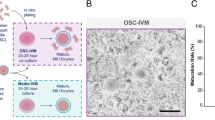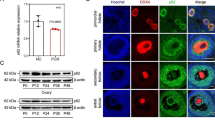Abstract
Purpose
Abnormal Zona Pellucida (ZP) of human oocytes is an extracellular oocyte abnormality leading to subfertility or infertility, among which indented ZP (iZP) is a common clinical case, and there is currently no effective clinical solution. The study aimed to find out the influence of this abnormal ZP on the growth and development of GC and further explore its influence on the growth and development of oocytes, hoping to provide new ideas for the etiology and treatment of such patients.
Methods
In this study, we collected granulosa cells GC from oocytes with iZP(four cases) and GC from oocytes with a normal appearance of the ZP(eight cases) during ICSI treatment cycles, and submitted them to transcriptomic analysis using next‐generation RNA sequencing (RNAseq).
Results
177 Differentially Expressed Genes (DEG) were identified by RNAseq analysis of Granulosa Cells (GC) from oocytes with a normal ZP morphological appearance and those with iZP. Correlation analysis of these DEGs showed that the expression levels of the immune factor CD274 and the inflammatory factors IL4R and IL-7R, which are positively associated with ovulation, were significantly down-regulated in the GC of oocytes with iZP. Hippo, PI3K-AKT, Ras and calcium signaling pathways related to oocyte growth and development, NTRK2 and its ligands (BDNF and NT5E) from the neurotrophin family that are trophic to the oocyte were also significantly down-regulated in the GC of oocytes with iZP. In addition, the expression of cadherin family members CDH6, CDH12 and CDH19 were significantly down-regulated in DEGs, and the down-regulation of these proteins may affect the gap junction between Granulosa cells and oocytes.
Conclusion
IZP might cause obstacles to dialogue and material exchange between GC and oocytes and further affect the growth and development of oocytes.






Similar content being viewed by others
Data availability
The data that support the findings of this study are available from the corresponding author, [GDY], upon reasonable request.
References
Rienzi L, Vajta G, Ubaldi F (2011) Predictive value of oocyte morphology in human IVF: a systematic review of the literature. Hum Reprod Update 17(1):34–45
Gupta SK (2021) Human zona pellucida glycoproteins: binding characteristics with human spermatozoa and induction of acrosome reaction. Front Cell Dev Biol 9:619868
Zhao M, Dean J (2002) The zona pellucida in folliculogenesis, fertilization and early development. Rev Endocr Metab Disord 3(1):19–26
Balaban B et al (1998) Oocyte morphology does not affect fertilization rate, embryo quality and implantation rate after intracytoplasmic sperm injection. Hum Reprod 13(12):3431–3433
Sauerbrun-Cutler MT et al (2015) Oocyte zona pellucida dysmorphology is associated with diminished in-vitro fertilization success. J Ovarian Res 8:5
Yang D et al (2022) Embryological characteristics of human oocytes with agar-like zona pellucida and its clinical treatment strategy. Front Endocrinol (Lausanne) 13:859361
Wyse BA et al (2020) Transcriptomics of cumulus cells—a window into oocyte maturation in humans. J Ovarian Res 13(1):93
Dobin A et al (2013) STAR: ultrafast universal RNA-seq aligner. Bioinformatics 29(1):15–21
Love MI, Huber W, Anders S (2014) Moderated estimation of fold change and dispersion for RNA-seq data with DESeq2. Genome Biol 15(12):550
Chin C-H et al (2014) cytoHubba: identifying hub objects and subnetworks from complex interactome. BMC Syst Biol 8(4):S11
Sousa M et al (2015) Embryological, clinical and ultrastructural study of human oocytes presenting indented zona pellucida. Zygote 23(1):145–157
Martinez-Canales S et al (2018) Functional transcriptomic annotation and protein-protein interaction analysis identify EZH2 and UBE2C as key upregulated proteins in ovarian cancer. Cancer Med 7(5):1896–1907
Vander Ark A, Cao J, Li X (2018) TGF-beta receptors: In and beyond TGF-beta signaling. Cell Signal 52:112–120
Wang S et al (2018) The mechanism of melatonin and its receptor MT2 involved in the development of bovine granulosa cells. Int J Mol Sci 19(7):2028
Cheng Y et al (2011) Oocyte-expressed interleukin 7 suppresses granulosa cell apoptosis and promotes oocyte maturation in rats. Biol Reprod 84(4):707–714
Oh D et al (2021) Effect of interleukin-7 on in vitro maturation of porcine cumulus-oocyte complexes and subsequent developmental potential after parthenogenetic activation. Animals (Basel) 11(3):741
Javvaji PK et al (2019) Interleukin-7 improves in vitro maturation of ovine cumulus-oocyte complexes in a dose dependent manner. Cytokine 113:296–304
Yu Y et al (2012) Effects of combined epidermal growth factor, brain-derived neurotrophic factor and insulin-like growth factor-1 on human oocyte maturation and early fertilized and cloned embryo development. Hum Reprod 27(7):2146–2159
Anderson RA (2014) Brainwork in the ovary: kisspeptin and BDNF signaling converge to ensure oocyte survival. Endocrinology 155(8):2751–2753
Chow R, Wessels JM, Foster WG (2020) Brain-derived neurotrophic factor (BDNF) expression and function in the mammalian reproductive tract. Hum Reprod Update 26(4):545–564
Anderson RA et al (2010) Brain-derived neurotrophic factor is a regulator of human oocyte maturation and early embryo development. Fertil Steril 93(5):1394–1406
Huang X et al (2013) Differences in the transcriptional profiles of human cumulus cells isolated from MI and MII oocytes of patients with polycystic ovary syndrome (PCOS). Reproduction 145(6):597–608
Bethea CL, Reddy AP (2012) Ovarian steroids increase glutamatergic related gene expression in serotonin neurons of macaques. Mol Cell Neurosci 49(3):251–262
Botkjaer JA et al (2015) Pregnancy-associated plasma protein A in human ovarian follicles and its association with intrafollicular hormone levels. Fertil Steril 104(5):1294-301e1
Pizzagalli MD, Bensimon A, Superti-Furga G (2021) A guide to plasma membrane solute carrier proteins. FEBS J 288(9):2784–2835
Vellano CP et al (2013) Assembly and function of the regulator of G protein signaling 14 (RGS14). H-Ras signaling complex in live cells are regulated by Galphai1 and Galphai-linked G protein-coupled receptors. J Biol Chem 288(5):3620–3621
Kon N et al (2021) mTOR inhibition acts as an unexpected checkpoint in p53-mediated tumor suppression. Genes Dev 35(1–2):59–64
Guo B et al (2021) Cadherin-12 regulates neurite outgrowth through the PKA/Rac1/Cdc42 pathway in cortical neurons. Front Cell Dev Biol 9:768970
Makrigiannakis A et al (2000) Follicular atresia and luteolysis evidence of a role for N-cadherin. Ann NY Acad Sci 900:46–55
Funding
This work was funded by National Natural Science Foundation of China, U1904138, Henan Provincial Science and Technology Research Project, SBGJ202102098.
Author information
Authors and Affiliations
Contributions
All authors contributed to the study conception and design. JYH, HHW, and RJ performed experiments, curated the data and revised the manuscript, GDY provided foundation support, conceived this study and supervised this research, GY, TWZ, and JYZ helped obtaining samples, polished the writing and embellished manuscript layout. All authors read and approved the final manuscript. JYH, HHW, and RJ should be considered joint first author, GDY should be considered corresponding author. All authors read and approved the final manuscript.
Corresponding author
Ethics declarations
Conflict of interest
The authors declare no conflicts of interest.
Additional information
Publisher's Note
Springer Nature remains neutral with regard to jurisdictional claims in published maps and institutional affiliations.
The authors “Jingyi Hu, Huihui Wang, Ran Jiang” are joint first author.
Supplementary Information
Below is the link to the electronic supplementary material.
Rights and permissions
Springer Nature or its licensor (e.g. a society or other partner) holds exclusive rights to this article under a publishing agreement with the author(s) or other rightsholder(s); author self-archiving of the accepted manuscript version of this article is solely governed by the terms of such publishing agreement and applicable law.
About this article
Cite this article
Hu, J., Wang, H., Jiang, R. et al. Effects of indented zona pellucida on oocyte growth and development explored from changes of gene expression in cumulus cells. Arch Gynecol Obstet 308, 1023–1033 (2023). https://doi.org/10.1007/s00404-023-07104-7
Received:
Accepted:
Published:
Issue Date:
DOI: https://doi.org/10.1007/s00404-023-07104-7




